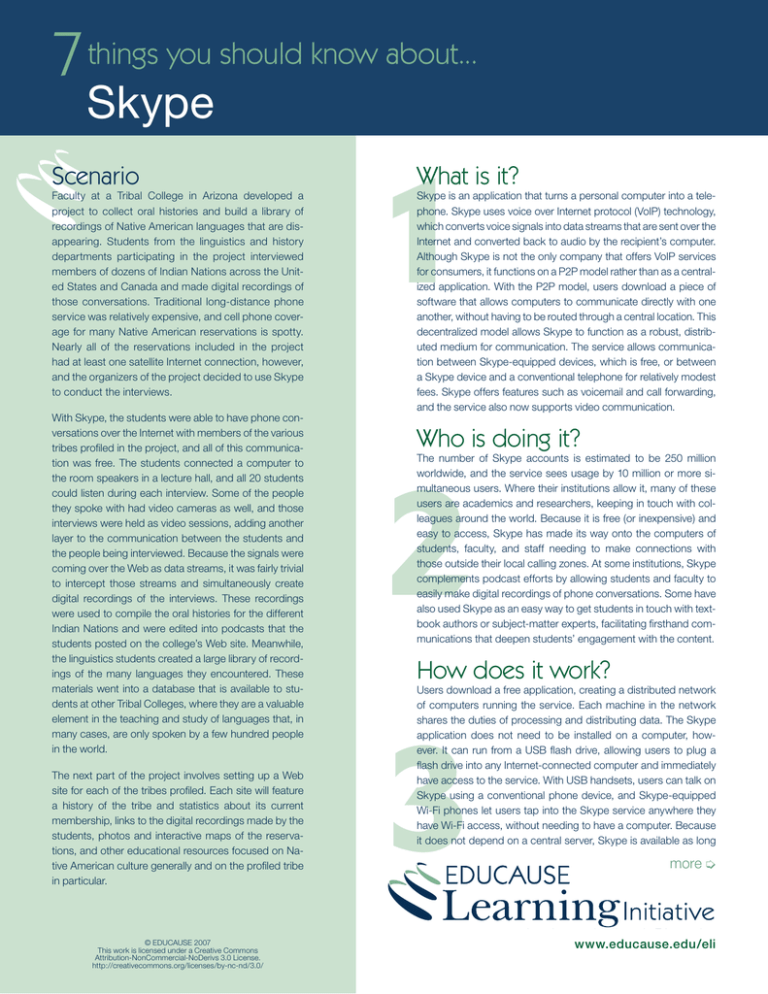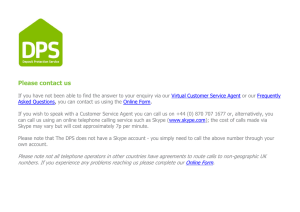7 Things You Should Know About Skype
advertisement

7 things you should know about... Skype Scenario Faculty at a Tribal College in Arizona developed a project to collect oral histories and build a library of recordings of Native American languages that are disappearing. Students from the linguistics and history departments participating in the project interviewed members of dozens of Indian Nations across the United States and Canada and made digital recordings of those conversations. Traditional long-distance phone service was relatively expensive, and cell phone coverage for many Native American reservations is spotty. Nearly all of the reservations included in the project had at least one satellite Internet connection, however, and the organizers of the project decided to use Skype to conduct the interviews. With Skype, the students were able to have phone conversations over the Internet with members of the various tribes profiled in the project, and all of this communication was free. The students connected a computer to the room speakers in a lecture hall, and all 20 students could listen during each interview. Some of the people they spoke with had video cameras as well, and those interviews were held as video sessions, adding another layer to the communication between the students and the people being interviewed. Because the signals were coming over the Web as data streams, it was fairly trivial to intercept those streams and simultaneously create digital recordings of the interviews. These recordings were used to compile the oral histories for the different Indian Nations and were edited into podcasts that the students posted on the college’s Web site. Meanwhile, the linguistics students created a large library of recordings of the many languages they encountered. These materials went into a database that is available to students at other Tribal Colleges, where they are a valuable element in the teaching and study of languages that, in many cases, are only spoken by a few hundred people in the world. The next part of the project involves setting up a Web site for each of the tribes profiled. Each site will feature a history of the tribe and statistics about its current membership, links to the digital recordings made by the students, photos and interactive maps of the reservations, and other educational resources focused on Native American culture generally and on the profiled tribe in particular. © EDUCAUSE 2007 This work is licensed under a Creative Commons Attribution-NonCommercial-NoDerivs 3.0 License. http://creativecommons.org/licenses/by-nc-nd/3.0/ 1 What is it? Skype is an application that turns a personal computer into a telephone. Skype uses voice over Internet protocol (VoIP) technology, which converts voice signals into data streams that are sent over the Internet and converted back to audio by the recipient’s computer. Although Skype is not the only company that offers VoIP services for consumers, it functions on a P2P model rather than as a centralized application. With the P2P model, users download a piece of software that allows computers to communicate directly with one another, without having to be routed through a central location. This decentralized model allows Skype to function as a robust, distributed medium for communication. The service allows communication between Skype-equipped devices, which is free, or between a Skype device and a conventional telephone for relatively modest fees. Skype offers features such as voicemail and call forwarding, and the service also now supports video communication. Who is doing it? 2 The number of Skype accounts is estimated to be 250 million worldwide, and the service sees usage by 10 million or more simultaneous users. Where their institutions allow it, many of these users are academics and researchers, keeping in touch with colleagues around the world. Because it is free (or inexpensive) and easy to access, Skype has made its way onto the computers of students, faculty, and staff needing to make connections with those outside their local calling zones. At some institutions, Skype complements podcast efforts by allowing students and faculty to easily make digital recordings of phone conversations. Some have also used Skype as an easy way to get students in touch with textbook authors or subject-matter experts, facilitating firsthand communications that deepen students’ engagement with the content. How does it work? Users download a free application, creating a distributed network of computers running the service. Each machine in the network shares the duties of processing and distributing data. The Skype application does not need to be installed on a computer, however. It can run from a USB flash drive, allowing users to plug a flash drive into any Internet-connected computer and immediately have access to the service. With USB handsets, users can talk on Skype using a conventional phone device, and Skype-equipped Wi-Fi phones let users tap into the Skype service anywhere they have Wi-Fi access, without needing to have a computer. Because it does not depend on a central server, Skype is available as long 3 more ➭ www.educause.edu/eli Skype as individual nodes are working. Skype offers a searchable directory of Skype users, as well as features including conference calling, file transfer, chat, and alerts. Beyond the free Skype-to-Skype calls, users can pay for premium services such as SkypeOut and SkypeIn. SkypeOut lets users call any regular phone from a Skype-equipped computer. Customers who use SkypeOut either pay for a package that provides unlimited calls within a geographic area, such as within the United States and Canada, or they pay per-minute charges that in most cases are considerably less than comparable charges from phone carriers. With SkypeIn, users pay for a conventional phone number that anyone with a regular phone can use to call the Skype user. Skype also ties in with a number of other applications, such as MySpace and eBay (which bought Skype in 2005). Users of eBay can set Skype alerts that notify them when someone bids on their items or when someone outbids them in an auction, and they can communicate through Skype with other eBay buyers and sellers. MySpace users can add Skype tools to their profile page and use them to connect with one another. Why is it significant? 4 In many places, new technologies have made landline phone service nearly obsolete. Finding a landline phone at all, not to mention one with long distance, is a challenge on some campuses. In some parts of the world, traditional telephone infrastructure was never fully developed or is controlled by monopolies. Cell phones address some of these issues, but coverage is far from universal, and costs remain a concern. In most circumstances, Skype provides access to voice and video communication for a fraction of what other options cost. Phone conversations are often preferable to an exchange of e-mail, and Skype gives phone access to people who might not be able to afford it otherwise—particularly in the case of international phone calls. Although the technologies it uses are not new, Skype brings them within reach of almost anyone, without going through the channels of an IT support desk. It allows more frequent contact between colleagues, collaborators, and friends and permits connections with those not likely to be in touch through conventional phone systems. Skype also saves traditional phone costs: when buying a SkypeIn number, users can choose the area code; someone in New York, for example, could have a SkypeIn number with an Atlanta area code, and anyone who calls that number from Atlanta won’t have to pay long-distance charges. 5 What are the downsides? Find more titles in this series on the ELI Web site www.educause.edu/eli have also noted that the Skype license requires users to grant access to the local network, which, they say, campus users are not authorized to do. Skype requires access to certain network ports, and many network administrators are uneasy allowing traffic to flow in and out of the network this way. University networks, which contain considerable amounts of sensitive information, are regular targets of hackers, and for many, Skype is another avenue for digital mischief. In addition, as with many P2P applications, Skype users are effectively anonymous, and this lack of accountability can be worrisome. 6 Where is it going? As concerns about bandwidth and security are addressed, more users will have access to Skype, and the service will continue to add features, improve quality, and tie in with other applications. Skype has shown that people are not only interested in free calls but also are willing to pay for services that are inexpensive compared to the alternatives. In this way, Skype might anticipate the evolution of voice and video communication by taking advantage of the power of the Web. To the extent that wireless Internet access approaches ubiquity, Skype becomes a legitimate competitor to cell phones, and this could have a profound impact on the communication landscape. In the meantime, vendors are introducing new Skype devices, some of which work as landline and Wi-Fi phones. One day people might make phone calls or have video conferences without having to know (or care) how that communication happens. 7 What are the implications for teaching and learning? By providing an easy, inexpensive way to communicate with people around the world, Skype opens the door to a wide range of activities that can improve student engagement and comprehension. Interacting with people from other states, countries, and continents helps students understand cultural differences, learn about history and social norms, and fine-tune foreign language skills. Learning becomes increasingly authentic as it expands beyond the walls of the classroom, and being able to have a phone call or a video chat with someone on the other side of the world can make learning come alive. An inexpensive, widely accessible tool like Skype also encourages faculty and students to experiment with new techniques to facilitate engagement. For distance education, Skype offers an easy way for disparate students and instructors to engage in synchronous communication. The sound quality from Skype is not as consistent and reliable as that of landline or cell phones. Skype also raises a number of concerns about security and resource consumption. Because of how Skype functions, any computer running the application might be used to relay others users’ calls. Due to concerns that Skype computers on campus will become such “supernodes” and use potentially large amounts of bandwidth, a number of colleges and universities have banned Skype. Some institutions www.educause.edu/eli December 2007



